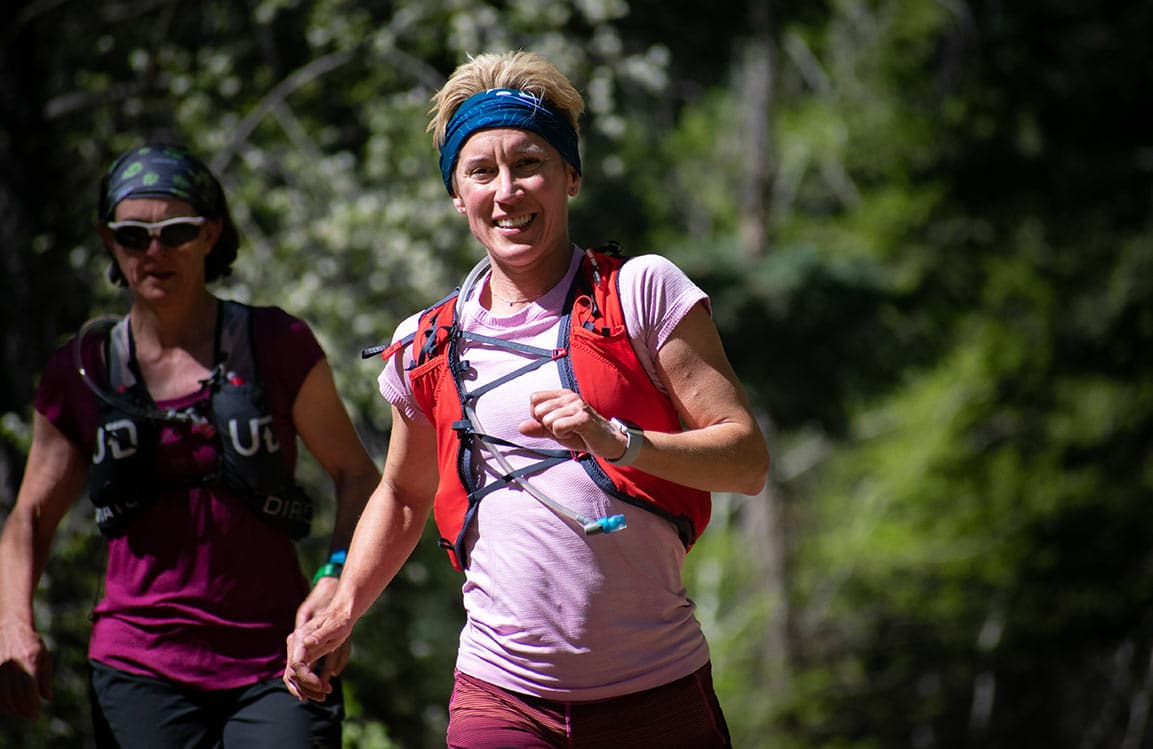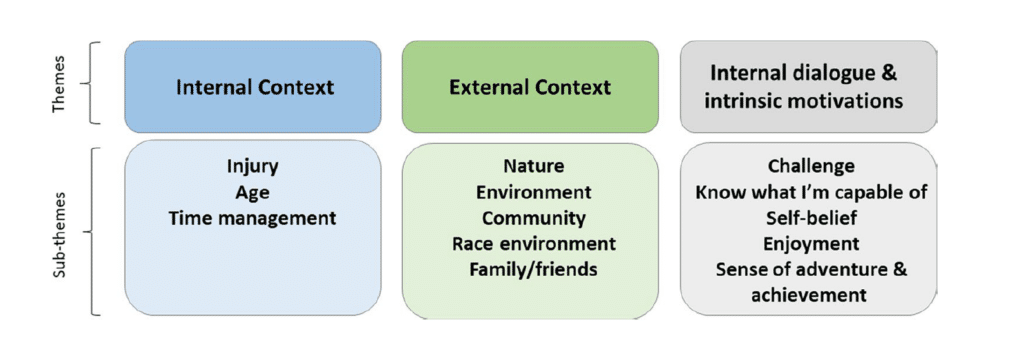
What’s Stifling the Growth of Female Participation in Ultrarunning?
By Corrine Malcolm,
CTS Expert Coach, Ultrarunning Host for the Trainright Podcast
I’ve spent much of the past two years engaging in conversations with individuals and organizations about how to increase female participation in trail and ultrarunning races. This largely has meant examining what the real and perceived barriers might be that stop someone from signing up for an ultra. Understanding these barriers is necessary at all levels within our sport, from the elites trying to make a living to people like my own mother getting into trail running in her 50s. With wide community support, we are slowly seeing changes, including improved hiring practices, greater gender parity in representation and pay and with sponsors, and race organizations opening or reserving spots specifically for women. So, I was intrigued when I saw a paper entitled Enablers and barriers in ultrarunning: a comparison of male and female ultrarunners this past spring. What might these researchers have found?
The researchers out of the University of West Scotland acknowledged that even though previous research has evaluated the sociodemographics of ultrarunners, their general physical health, and some psychological factors, those studies all focused on performance differences between male and female runners. By only focusing on performance differences they had not evaluated the gender differences in motivations, barriers and/or constraints experienced in sport, which leaves us with an incomplete picture.
To evaluate these real and perceived barriers, the researchers wanted to evaluate the three aspects of constraints for leisure activities: intrapersonal (psychology, preferences and predisposition), interpersonal (relation with others), and structural (social factors). They also wanted to examine something known as ‘negotiation efficacy’, which is one’s belief in their ability to negotiate with and around these constraints. This negotiation is important for endurance athletes because training for long races requires significant time, which means you must balance (negotiate) with/around other commitments such as family, friends, and work. Their theory was that there might be similar barriers/constraints imposed on both male and females, but that maybe one gender has inherently higher levels of negotiation efficacy and thus makes it to more start lines over time.
The research team utilized an online questionnaire and a qualitative follow-up phone interview for runners participating in one of two Scottish ultra-marathons: the Jedburgh 3 Peaks ultra or the Highland Fling Race. They ended up with 640 complete responses. Through the questionnaire responses and interviews they were able to identify three clear themes and associated subthemes:
- Internal Context (Injury, Age, Time Management)
- External Context (Nature, Environment, Community, Race Environment, Family/Friends)
- Internal Dialogue/Intrinsic Motivations (Challenge, Self-belief, Enjoyment, Adventure, Achievement).
The biggest takeaways from these themes were:
- Athletes looked at age as both a positive and a potential limiting factor. Some runners looked to training for ultras as a way to ‘stave off aging’. Many more runners looked at age as a limiting factor, both in terms of causing them to slow down (to the point of missing cutoffs) and increasing fear they were at greater risk for injury.
- The largest limiting factor reported by both male and female athletes was time to train, primarily due to family and work commitments, and negotiating time was a hurdle.
- Negotiating time around family and work commitments was easier when both partners or the whole family were involved in the sport.
- Females cited delaying taking up running to prioritize family, particularly while their children were young, and this response was not identified in the male participants.
- While poor weather was considered a factor that frequently limited training, both males and females reported spending time outside and in nature as something that largely contributed to their enjoyment of training and racing.
- Both male and females cited curiosity and wanting to explore their limits as reasons for signing up for an ultra-event, although women were less likely to sign up for an ultra if they weren’t completely sure they could complete the distance.
- Friends and the wider ultrarunning community were the biggest enablers for both getting athletes involved in ultrarunning and keeping them in the sport.
With similar responses from their male and female volunteers regarding constraints, barriers, and obstacles, the researchers were still left wondering why fewer women were getting to start lines. This pointed them back to their original question: did one gender have inherently higher levels of negotiation efficacy, allowing them to navigate these constraints more readily?
The researchers felt this was highlighted in their own study with women, stating they delayed their entry into sport because of family, which is mirrored in other research, wherein most women taking part in short distance races did not have children. This is likely tied back to females having a lower inherent sense of entitlement to take part in leisure activities due to traditional family roles, thus heightening the constraint of time on training. At the same time, we are also watching traditional family roles shift, with both parties involved in childcare and more women actively working outside the home. Despite societal changes, females still must contend with decades and decades of internalized social expectations regarding what makes ‘good motherhood’.
It’s suggested that with these gradual shifts to more egalitarian family roles that, over time, the ship might right itself, but is that reason enough to do nothing? Personally, I do not think so. What this research points out, is that there is a very real and nuanced difference in negotiation-efficacy between genders. And that difference, even if subtle, is likely the key reason for different levels of participation between males and females in the sport of ultrarunning.
► Free Ultrarunning Training Assessment Quiz
Take our free 2-minute quiz to discover how effective your training is and get recommendations for how you can improve.
So, what can we do if we are not willing to sit back and wait? The real and perceived constraints placed on both male and female ultrarunners’ ability to train can be overcome. We can lead by example as an industry, hiring more female coaches, and supporting brands that fight for equal representation. We can support organizations, initiatives, and race organizers (hello, family-friendly events!) that make entry into the sport easier for parents (particularly mothers), so they can negotiate the time they need to train and race. We can highlight masters athletes, particularly moms and dads, so that other runners can recognize they too have a place in the sport. And you, the individual can support your community. Maybe that’s taking a tag team approach with the kids so everyone can get out, or volunteering to be a runner’s childcare provider as part of their race day crew. I say, why sit and wait when we can make big and small actionable changes that welcome more runners (and families) into our sport?
Reference:
Enjoying This Article? Get More Free Running Training Tips
Get our coaches' best training advice, delivered straight to your inbox weekly.
Valentin, L. A. Pham & E. Macrae (2021): Enablers and barriers in ultra-running: a comparison of male and female ultra-runners, Sport in Society, DOI: 10.1080/17430437.2021.1898590
https://doi.org/10.1080/17430437.2021.1898590


Comments 5
Thanks, for such a great post. it is very helpful. I always prefer to read the quality content and this thing I found in your post. Thank you and good luck with the upcoming Blog.
Thanks! Great info.
Tight check point cut offs made by and for male runners.
It’s all become so elitist and who wants to be beasted by race directors who’s only priority is getting their race in the ‘its so hard’ books.
The research focused on people actually signed up for an ultra – so it doesn’t include those for whom barriers have prevented them from getting that far. That might explain why there’s less difference in the responses that was apparently expected: the researchers have failed to capture the people (possibly or even probably particularly women) who never got as far as entering the races.
That’s an excellent point. The other issue is that it doesn’t capture is women who trail run but don’t compete. I know of a number of women locally in our small town who are excellent trail runners that have preformed exceptionally when they do race but prefer to use their time to explore rather than prepare for races. While I’m all for reducing barriers to women’s participation, do we really need to increase numbers? Trail running isn’t necessarily everyone’s thing. This is coming from a woman who started running in her 50’s after more than 20 years of bike racing. I love the low key aspect of the sport that reminds me of endurance mountain bike racing in the late 90’s. Competing keeps me consistent with my training but it doesn’t work for everyone.